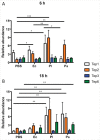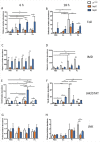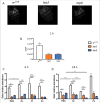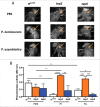The distinct function of Tep2 and Tep6 in the immune defense of Drosophila melanogaster against the pathogen Photorhabdus
- PMID: 28498729
- PMCID: PMC5810505
- DOI: 10.1080/21505594.2017.1330240
The distinct function of Tep2 and Tep6 in the immune defense of Drosophila melanogaster against the pathogen Photorhabdus
Abstract
Previous and recent investigations on the innate immune response of Drosophila have identified certain mechanisms that promote pathogen elimination. However, the function of Thioester-containing proteins (TEPs) in the fly still remains elusive. Recently we have shown the contribution of TEP4 in the antibacterial immune defense of Drosophila against non-pathogenic E. coli, and the pathogens Photorhabdus luminescens and P. asymbiotica. Here we studied the function of Tep genes in both humoral and cellular immunity upon E. coli and Photorhabdus infection. We found that while Tep2 is induced after Photorhabdus and E. coli infection; Tep6 is induced by P. asymbiotica only. Moreover, functional ablation of hemocytes results in significantly low transcript levels of Tep2 and Tep6 in response to Photorhabdus. We show that Tep2 and Tep6 loss-of-function mutants have prolonged survival against P. asymbiotica, Tep6 mutants survive better the infection of P. luminescens, and both tep mutants are resistant to E. coli and Photorhabdus. We also find a distinct pattern of immune signaling pathway induction in E. coli or Photorhabdus infected Tep2 and Tep6 mutants. We further show that Tep2 and Tep6 participate in the activation of hemocytes in Drosophila responding to Photorhabdus. Finally, inactivation of Tep2 or Tep6 affects phagocytosis and melanization in flies infected with Photorhabdus. Our results indicate that distinct Tep genes might be involved in different yet crucial functions in the Drosophila antibacterial immune response.
Keywords: Drosophila; Photorhabdus; immunity; thioester-containing protein.
Figures







Comment in
-
Thioester-containing proteins: At the crossroads of immune effector mechanisms.Virulence. 2017 Nov 17;8(8):1468-1470. doi: 10.1080/21505594.2017.1355662. Epub 2017 Aug 8. Virulence. 2017. PMID: 28704162 Free PMC article. No abstract available.
Similar articles
-
Thioester-Containing Proteins 2 and 4 Affect the Metabolic Activity and Inflammation Response in Drosophila.Infect Immun. 2018 Apr 23;86(5):e00810-17. doi: 10.1128/IAI.00810-17. Print 2018 May. Infect Immun. 2018. PMID: 29463615 Free PMC article.
-
Thioester-Containing Protein-4 Regulates the Drosophila Immune Signaling and Function against the Pathogen Photorhabdus.J Innate Immun. 2017;9(1):83-93. doi: 10.1159/000450610. Epub 2016 Oct 22. J Innate Immun. 2017. PMID: 27771727 Free PMC article.
-
The Drosophila Thioester containing Protein-4 participates in the induction of the cellular immune response to the pathogen Photorhabdus.Dev Comp Immunol. 2017 Nov;76:200-208. doi: 10.1016/j.dci.2017.06.008. Epub 2017 Jun 19. Dev Comp Immunol. 2017. PMID: 28642050
-
Thioester-containing Proteins in the Drosophila melanogaster Immune Response against the Pathogen Photorhabdus.Insects. 2020 Jan 28;11(2):85. doi: 10.3390/insects11020085. Insects. 2020. PMID: 32013030 Free PMC article. Review.
-
The host defense of Drosophila melanogaster.Annu Rev Immunol. 2007;25:697-743. doi: 10.1146/annurev.immunol.25.022106.141615. Annu Rev Immunol. 2007. PMID: 17201680 Review.
Cited by
-
Thioester-Containing Proteins 2 and 4 Affect the Metabolic Activity and Inflammation Response in Drosophila.Infect Immun. 2018 Apr 23;86(5):e00810-17. doi: 10.1128/IAI.00810-17. Print 2018 May. Infect Immun. 2018. PMID: 29463615 Free PMC article.
-
Quorum-sensing regulator RhlR but not its autoinducer RhlI enables Pseudomonas to evade opsonization.EMBO Rep. 2018 May;19(5):e44880. doi: 10.15252/embr.201744880. Epub 2018 Mar 9. EMBO Rep. 2018. PMID: 29523648 Free PMC article.
-
Evolution and Function of Thioester-Containing Proteins and the Complement System in the Innate Immune Response.Front Immunol. 2017 Jun 29;8:759. doi: 10.3389/fimmu.2017.00759. eCollection 2017. Front Immunol. 2017. PMID: 28706521 Free PMC article. Review.
-
Thioester-containing protein TEP15 promotes malaria parasite development in mosquitoes through negative regulation of melanization.Parasit Vectors. 2025 Apr 1;18(1):124. doi: 10.1186/s13071-025-06772-5. Parasit Vectors. 2025. PMID: 40170182 Free PMC article.
-
Rapid seasonal evolution in innate immunity of wild Drosophila melanogaster.Proc Biol Sci. 2018 Jan 10;285(1870):20172599. doi: 10.1098/rspb.2017.2599. Proc Biol Sci. 2018. PMID: 29321302 Free PMC article.
References
-
- Lemaitre B, Hoffmann J. The host defense of Drosophila melanogaster. Ann Rev Immunol 2007; 25:697-743; PMID:17201680; https://doi.org/ 10.1146/annurev.immunol.25.022106.14161510.1146/annurev.immunol.25.022106.141615 - DOI - PubMed
-
- Pal S, Wu LP. Pattern recognition receptors in the fly: lessons we can learn from the Drosophila melanogaster immune system. Fly (Austin) 2009; 3:121-9; PMID:19440043; https://doi.org/ 10.4161/fly.882710.4161/fly.8827 - DOI - PubMed
-
- Buresova V, Hajdusek O, Franta Z, Sojka D, Kopacek P. IrAM-An alpha2-macroglobulin from the hard tick Ixodes ricinus: characterization and function in phagocytosis of a potential pathogen Chryseobacterium indologenes. Dev Comp Immunol 2009; 33:489-98; PMID:18948134; https://doi.org/ 10.1016/j.dci.2008.09.01110.1016/j.dci.2008.09.011 - DOI - PubMed
-
- Blandin S, Shiao SH, Moita LF, Janse CJ, Waters AP, Kafatos FC, Levashina EA. Complement-like protein TEP1 is a determinant of vectorial capacity in the malaria vector Anopheles gambiae. Cell 2004; 116:661-70; PMID:15006349; https://doi.org/ 10.1016/S0092-8674(04)00173-410.1016/S0092-8674(04)00173-4 - DOI - PubMed
-
- Xiao X, Liu Y, Zhang X, Wang J, Li Z, Pang X, Wang P, Cheng G. Complement-related proteins control the flavivirus infection of Aedes aegypti by inducing antimicrobial peptides. PLoS Pathog 2014; 10:e1004027; PMID:24722701; https://doi.org/ 10.1371/journal.ppat.100402710.1371/journal.ppat.1004027 - DOI - PMC - PubMed
Publication types
MeSH terms
Substances
Grants and funding
LinkOut - more resources
Full Text Sources
Other Literature Sources
Molecular Biology Databases
